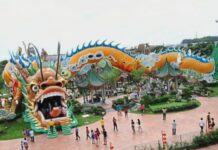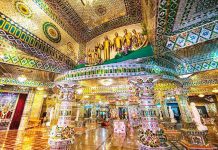JOHOR BAHRU 12 Sept – Muar, the fourth biggest town in booming Johor after the city of Johor Bahru, Batu Pahat, and Kluang – is steeped in history and is a must-visit tourist attraction for both locals and foreigners.
This Royal Town often described as a laid-back pensioner’s paradise has plenty to offer. Not many are aware that Muar is an added boost to tourism in Johor after winning the ASEAN Cleanest Tourist City in 2018.
It was thanks to the Muar Municipal Council’s hard work in promoting cleanliness through gotong-royong, recycling activities, and preservation of canal, rivers, and landscapes in the district.
Tourism in Johor is a major money-spinner and Muar has its own uniqueness in drawing tourists. It is rich in history and heritage apart from being famous for its food.
It is famous for its Otak-Otak, Mee Bandung Muar, Asam Pedas, Satay, Ikan Bakar, Laksa Johor, Nasi Ambeng, Lontong, Fried Oyster Omelette, and it’s famed 434 coffee made with freshly roasted beans.

Not forgetting that Muar is probably the only town in the country that serves satay for breakfast and it is a must for visitors.
Visitors and locals are also drawn to Dataran Tanjung Emas roundabout and the fountain with a sculpture carrying the Johor Royal Crest of Arms which is a delight to watch when it is lighted up at night. Tanjung Emas is also where you can watch the beautiful sunset across the river mouth.

Muar was previously known as Bandar Maharani. The name was given by Sultan Abu Bakar in 1884.
It was named the Royal Town by His Majesty Sultan Ibrahim Ibni Almarhum Sultan Iskandar on Nov 24 2012, in conjunction with the Johor ruler’s birthday celebrations.
Pre-war buildings in Muar reflect their British, Chinese, Indian, Dutch Malay and, Peranakan elements in designs to preserve history.
An interesting point in its history, Muar, is the only city in the country which had its own railway system during the British colonial era and managed by the Muar State Railways (MSR) and was built in 1889 – the second railway system network built in the country after the first railway line from Taiping to Port Weld in Perak in 1885 – according to records in the National Archives.
The ferry is also part of Muar’s history. From 1884 to 1967 Muar Ferry Service connected Muar to other states in the north and operated from Pengkalan Tanjung Agas to Pengkalan Tanga Batu. It was terminated in 1967 when the Sultan Ismail Bridge was completed.
A new Muar Second Bride connection Parit Bunga in the north and Sabak Awor in the south was completed in 2005 to ease traffic congestion on Sultan Ismail Bridge and the town.
Muzium Bukit Kepong is a must-visit for visitors, both local and foreign, as it is steeped in history for the country’s fight against communists.














